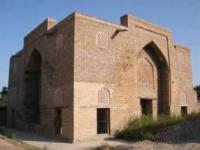You are here
Ak-Serai mausoleum.


Monuments Temurids in Samarkand.
“...it seemed a part of her life, to step from the ancient to the modern, back and forth. She felt rather sorry for those who knew only one and not the other. It was better, she thought, to be able to select from the whole menu of human achievements than to be bound within one narrow range”
Orson Scott Card.
Excursion tours to Ak-Serai mausoleum.
The mausoleum of Ak-Serai is located to the southeast from Gur-Emir, deep in dwelling quarter of the old city. The majority of scholars agree that it is a male necropolis of the last Samarkand Temurids.
The mausoleum dates from the 1470s, when dynastical necropolis Gur-Emir had exhausted its space for burying. Another Temurid mausoleum - Ishrat-khana, probably, was constructed in the same years.
The possible customer of the late mausoleums – Abu Sa’id (1451 - 1468/9) from the Temurids, which in the mid-XV century, conquered Samarkand and Maverannahr with the help of nomadic Uzbeks, headed by Abulhayr-khan.
The closest adviser of Abu Sa’id was Khodja Akhrar, a chief of Central Asian Sufis "naqshbandiyyah". In 1457, Abu Sa’id conquered Khurasan and became the third, after Amir Temur and Shahruh, Temurid king, which succeeded in centralizing of Maverannahr and Khurasan.
He transferred the capital to Heart. In 1468 - 1469 Abu-Sa’id was killed in the battle with Turkmen Ak-Koyunli in Azerbaijan. Externally, Ak-Serai with its not-decorated walls and not finished external dome makes impression of simplicity. However, the building has a composite layout.
It includes the memorial hall (ziaratkhana), cross-shaped in plan, the corner cells and three-parted hall. From here, the passage is going down to the underground octahedral crypt, facing with marble.
At its eastern wall, inside a special niche faced with marble, there is a tomb of some headless person. According to one of existing versions, he is a son of Ulugbeg, Abdullatif (1449 - 1550), which lost his head after dethronement.
The hall is covered by a dome on crossed arches and pendentives. The panel with remains of refined mosaics decorates the lower parts of walls. The walls, pendentives and dome are covered with the ornamental paintings, done in technique of "kundal", richly gilded.
Authority:
Alexey Arapov. Samarkand. Masterpieces of Central Asia. Tashkent, San’at. 2004.







